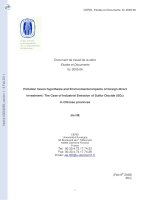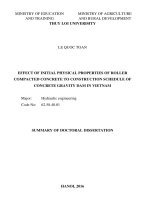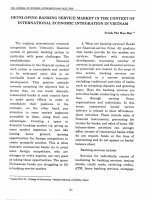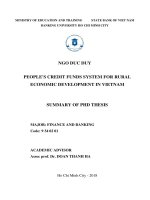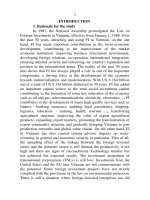Summary of doctoral thesis impacts of public investment on private investment the case of key economic regions in vietnam
Bạn đang xem bản rút gọn của tài liệu. Xem và tải ngay bản đầy đủ của tài liệu tại đây (2.43 MB, 27 trang )
MINISTRY OF EDUCATION
FOREIGN TRADE
SUMMARY
AND TRAINING
UNNIVERSITY
OF DOCTORAL THESIS
IMPACTS OF PUBLIC INVESTMENT ON PRIVATE
INVESTMENT:
THE CASE OF KEY ECONOMIC
IN VIETNAM
Major: International Economics
Code: 9310106
HO THI HOAI THUONG
HA NOI - 2023
REGIONS
The thesis is completed at Foreign Trade university
Science Instructor: Assoc. Prof. Dr. Nguyen Thi Thuy Vinh
Reviewer |:
Reviewer 2:
Reviewer 3:
The thesis will be defended in front of the thesis committee at University level
at Foreign Trade university
At hour ... date ... month...
year 2023
The thesis can be consulted at the National Library and Library of Foreign
Trade University
INTRODUCTION
1. Rationale of the research
In the context of international economic integration, public investment has a great
role in promoting economic development, especially in building socio-economic
infrastructure, creating a favorable environment for business, and thereby improving
the competitiveness of the private sector. In addition, increasing public investment in
socio-economic infrastructure is also one of the important factors attracting foreign
direct investment (FDI) and increasing the country's development resources. In
Vietnam, the rapidly increasing scale of public investment has contributed to Vietnam's
high growth for a long time. Public investment is often referred to as “priming
investment” to attract and lead private investment, create impetus for socio-economic
development in localities and economic regions of the country. In addition, Vietnam is
integrating more deeply into the world economy by implementing a roadmap to reduce
tariffs according to commitments.
At that time, to ensure growth, the Government
needs to increase public investment in economic infrastructure (roads, bridges, ports...)
and social infrastructure (schools, hospitals...) to improve the investment environment
and business environment.
Currently, Vietnam has four key economic regions, including the Northern Key
Economic Region, the Central Key Economic Region, the Southern Key Economic
Region and the Mekong Delta Key Economic Region with a total of 24 provinces and
cities. The Government has identified these as the driving force behind the
development of other regions across the country. These are also key areas for public
investment, private investment and contribute much to the country's economic growth.
Although playing a leading role in creating an infrastructure foundation to attract
private investment in the region and the whole country, over the years, the role of public
investment in key economic regions has been considered as weak (Tran Du Lich,
2021). In fact, public investment in infrastructure of key economic projects has made
many achievements in creating a stimulus to attract private investment, especially in
economic zones and industrial parks (Nguyen Thi Chinh, 2020; Nguyen Thi Thanh
Huyen et al., 2022). However, in many cases, the attraction is not effective and has not
created the motivation to attract private investment. Specifically, the infrastructure of
transport, seaports, railways and urban areas has not been synchronized due to lack of
regulation and regional planning, so it has not been able to promote its advantages,
efficiency and create guidance for the private sector (Tran Duy Dong, 2022). In
addition, public investment puts great pressure on the state budget because the same
key economic regions need a large resource to serve regional linkage investment
projects, thereby creating a debt burden on the loan capital market and negatively
affecting private investment (Do Thi Thanh Huyen et al., 2021). Therefore, whether
public investment has a crowding - out or crowding — in effect on private investment
in Key Economic Regions is still a controversial issue
In addition, from the perspective of research, the impact of public investment on
private investment is a topic of interest to many scientists, but the mechanism and
results of the impact are controversial. Many studies show that public investment has
a crowding-in effect on private investment. Specifically, adequate public investment in
infrastructure improves market access, reduces production costs, and increases private
investment (ASchauer,1989a; Saidjada et al., 2016; Makuyana, 2016 and Ouedraogo
& associates, 2019). In addition, government investment in human capital (such as
education and health), spending on research and development contribute to the
formation of human capital, improve labor productivity and promote private
investment (Lall, 2007; Daniele, 2009; Flores-Chamba & associates, 2019; Jena &
Barua, 2020). However, other research suggests that public investment can have a
crowding-out effect on private investment when large demand for government
development investment may cause rising interest rates on the loan market to reduce
private sector access to capital (Friedman, 1978; Ganelli, 2003; Kustepeli, 2005;
Cavallo & Daude, 2011). In addition, raising taxes or borrowing to finance government
spending also makes it difficult for the private sector to access the scarce financial
resources of the economy (Pereira & Andraz, 2004; Drezgié, 2011; Rodriguez-Pose &
et al., 2012; Solihin & associates, 2021). The impact of public investment on private
investment is controversial in the short term and in the long term, as well as when
considering the impact of components of public investment on the components of
private investment (Pereira et al., 2001; Castillo & et al., 2005; Ngeendepi et al., 2021;
Babu et al., 2022). Thus, in terms of research, the impact of public investment on
private investment is one of the issues that causes a lot of debate and it is necessary to
study this issue systematically and comprehensively
Meanwhile, it can be seen that there are many studies on public investment and
public investment efficiency in Vietnam (Nguyen Hong Thang, 2009; Hoang The Anh,
2014; Diep Gia Luat, 2015; Tran Vu Phong, 2018; Dao Thi Ho Huong, 2021; Pham
Thi Thanh Binh, 2023). However, there is a lack of in-depth studies on the impact of
public investment on private investment, especially empirical studies testing the
crowding-out and crowding-in effects of public investment on investment in both the
short and long term, or studies of the impact of public investment on specific
components of private investment. On the other hand, to the knowledge of the
researcher, no research has been conducted in terms of qualitative and quantitative
aspects for 24 provinces/cities in key economic regions.
Based on the theoretical and practical gaps mentioned above, the author selected
“Impacts of public investment on private investment: The case of Key Economic
Regions in Vietnam” as a research topic for the thesis
2. Research objects and tasks
2.1 Research objects
The research objective of the thesis is to analyze the impact of public investment
on private investment in key economic regions in Vietnam. In particular, the author
proposes solutions to implement public investment to promote private investment in
Vietnam’s key economic regions.
2.2 Research tasks
To
achieve
the above
basic
research
objectives,
following specific theoretical and experimental tasks
the thesis will
perform
the
4
First, provide the theoretical basis for public investment, private investment,
channels of impact of public investment on private investment and the theory of key
economic regions. Second, analyze the actual impact of public investment on private
investment in key economic regions. In addition, test the impact ofpublic investment
on private investment in Vietnam’s key economic regions during the research period
is based on quantitative analytical models.
Third, propose solutions to implement
public investment to promote private investment in Vietnam’s key economic regions.
2.3 Research questions
The thesis aims to answer the following main research questions:
First, is the impact of public investment crowding out or crowding in private
investment, the components of private investment in key economic regions in Vietnam
and whether this impact changes in the short term and long term? Second, how does
public investment in infrastructure affect private investment in key economic regions
in Vietnam? Third, how should public investment policies in key economic regions be
implemented to promote private investment towards 2030?
3. Object and scope of research
3.1 Research object
The thesis studies the impact of public investment on private investment in key
economic regions in Vietnam.
3.2 Research scope
Scope of content: The thesis studies the impact of public investment on private
investment from the perspective of total public investment affecting the components of
domestic private investment (investment in the household and private sectors) in
Vietnam’s key economic regions.
Scope of time: The study uses the data covering the period from 2010 to 2021
Scope of space: The thesis studies the impact of public investment on private
investment in 4 key economic regions in Vietnam with 24 provinces/cities.
4. Research methods
Qualitative research methods: the author employs the meta-analysis and
descriptive
statistics to synthesize
previous
research,
complete
framework and serve as a basis for proposing policies in the thesis.
the theoretical
Quantitative research methods: the author uses Pool Mean Group estimator (PMG)
to analyze the impact of public investment on private investment in 4 key economic
regions regarding the short run and the long run. In addition, the author uses the noncausality test proposed by Juodis et al. (2021) for panel data to examine the impact of
public investment in infrastructure on investment for each region.
5. New contributions of the thesis
5.1 Theoretical contributions
First, the thesis has synthesized and clarified theoretical issues about regions,
economic regions and key economic regions. At the same time, through the theoretical
basis and previous empirical studies, the thesis has clearly indicated the impact channel
of public investment on private investment. Since then, the study has built a framework
to analyze the impact of public investment on private investment. Second, the thesis
uses appropriate econometric models to assess the impact of public investment on
investment private sector in key economic regions.
5.2 Practical contributions
First, through quantitative analysis, the thesis has shown the impact of public
investment on private investment, private investment in the enterprise sector, and
private investment in the household sector in the regions. Second, from the analysis of
quantitative results, the thesis proposes a policy of using public investment to promote
private investment from the overall perspective of key economic regions. At the same
time, the thesis also proposes solutions for each key economic region, which are
appropriate to the economic development situation, structure of public investment,
private investment and orientation of public investment policy towards 2030.
6. Structure of the thesis
In addition to the introduction and conclusion, the thesis consists of 6 chapters.
Chapter 1: OVERVIEW OF RESEARCH
Chapter 2: THEORETICAL
SITUATION
BACKGROUND
FOR THE IMPACT OF PUBLIC
INVESTMENT ON PRIVATE INVESTMENT AND KEY ECONOMIC
REGIONS
Chapter 3: RESEARCH METHOD
Chapter
VIETNAM
Chapter
4:
SITUATION
OF
PUBLIC
AND
PRIVATE
INVESTMENT
IN
‘S KEY ECONOMIC REGIONS
5: QUANTITATIVE
ANALYSIS
OF
THE
IMPACT
INVESTMENT ON PRIVATE INVESTMENT IN VIETNAM
OF
PUBLIC
‘S KEY ECONOMIC
REGIONS
Chapter 6: POLICY
INVESTMENT
ECONOMIC
IMPICATIONS
TO PROMOTE
REGIONS,
PRIVATE
FOR
IMPLEMENTATION
INVESTMENT
OF
PUBLIC
IN VIETNAM
‘S KEY
CHAPTER 1: OVERVIEW OF RESEARCH SITUATION
1.1 Research overview
1.1.1 Studies on the crowding-out effect of public investment on private
investment
First, studies analyze the crowding - out effect of public investment on private
investment within a particular country, or group of countries (Pradhan et al., 1990;
Bilgili 2003; Nazmi and Ramirez, 1997; To Trung Thanh, 2012). Second, the studies
also separate public investment into investment categories and study the impact of
those categories on private investment (Pereira, 2000; Rahman et al., 2015; Dada,
2013; Omotogun et al., 2018; Nguyen Thi Canh et al., 2020; Nguyen Thi Thuy Lien,
2022). Third, the studies also focus on the crowding - out effect ofpublic investment
on private investment in different sectors of the economy. Fourth, studies show that
the crowding - out effect of public investment on investment is still controversial when
analyzing in the short and long term (Castillo et al., 2005; Mitra, 2006; Nguyen Thi
Chinh, 2017; Mose et al., 2020; Nguyen Thi Thanh Huyen et al., 2022).
1.1.2 Studies on the crowding-in effects of public investment on private
investment
First, studies analyze the crowding — in effect of public investment on private
investment within a country or a group of countries (Hatano, 2010; Naqvi, 2003; Erden
and Holcome, 2005; Mitra, 2014; Abiad et al., 2016). Second, in addition to studies on
the crowding — in effects of public investment on private investment from the
perspective of total public investment, there are also studies on investment division.
The analysis of components by sector of investment and study of the effects of those
components on private investment (Aschauer, 1989a; Xu and Yan, 2014; Saidjada et
al. 2016; Makuyana, 2016 and Ouedraogo et al., 2019). Third, some studies also
analyze the crowding — in effects of public investment on private investment from the
perspective of sectors (Saseed et al., 2006; Fujii et al., 2013; S. Muthu, 2017; Nguyen
Thi Thuy Lien, 2022).
1.2 Research gap
1.2.1 Research content
First, there are currently very few studies on the impact of public investment on
private investment at the economic region level, and in particular, there is no study
analyzing the impact of public investment on private investment in key economic
regions in Vietnam. Second, there are quite a few studies on the impact of public
investment on private investment. However, there is a lack of in-depth studies on the
relationship between public investment and private investment in Vietnam. Third, there
are currently very few studies that divide private investment into different components
according to capital sources and specify the impact of public investment on those
components
1.2.2 Research method
First, most of the studies in Vietnam when studying from the perspective of
provinces/cities use panel data series with methods such as VAR, POLS, FMOLS,
DOLS. Second, there are currently very few studies that clearly show the role of public
investment in infrastructure on how private investment affects private investment, and
there are no studies that clearly indicate the impact of this investment on investment of
business and household sectors.
CHAPTER 2: THEORETICAL
BACKGROUND
FOR THE IMPACT OF
PUBLIC INVESTMENT ON PRIVATE INVESTMENT AND KEY
ECONOMIC
REGIONS
2.1 The basics of public and private investment
2.1.1 Public investment
2.1.1.1 Definition
a. The concept of public investment in the world
It can be seen that the concept of public investment in the world has three main
points of view. The first point of view emphasizes the owners of the capital of public
investment. The second view emphasizes the purpose of public investment. The third
view is a combination of the owner of the public investment capital and the purpose of
the public investment. In this view, public investment is understood as the use of state
capital to invest in non-profit programs and projects.
b. The concept of public investment in Vietnam
To remove limitations and shortcomings, on June 13, 2019, the National Assembly
passed the Law on Public Investment 2019. According to Clause 15, Article 4 of the
Law on Public Investment 2019, public investment is "investment by the State in
programs, projects and other public investment objects in accordance with the Law on
Public Investment".
2.1.1.2 Classification of public investment
2.1.1.3 The role of public investment
2.1.2 Private investment
2.1.2.1 Definition
Private investment differs from public investment in the ownership nature of the
investment capital and the investment purpose. Private investment is the investment of
private economic sectors while public investment is the investment of the State. The
purpose of private investment is to make a profit while the purpose of public investment
is to serve socio-economic development, not for profit.
Currently, in the official statistics of Vietnam, investment is classified according to
3 economic
sectors,
namely
"State",
"non-State"
and
"Foreign-invested
sector"
Accordingly, within the scope of this thesis, private investment will be understood as
investment using capital owned by the non-State investment.
Therefore, private
investment in the research scope of the thesis does not include investment of the foreign
invested capital sector ((FDI). Public investment is an investment that owns capital in
the State sector or is State investment.
2.1.2.2 Components of private investment
2.1.2.3 Factors affecting private investment
2.1.3 The impact of public investment on private investment
10
Theoretically, the impact of public investment on private investment is explained
through two main points of view. A first view favors that public investment creates a
crowding-out effect on private investment (Blejer and Khan, 1984; Beck, 1993; Voss,
2002; Ganelli, 2003; Kustepeli, 2005; Liitfi Erden, 2005; Ang, 2009; Cavallo and
Daude, 2011). A second view favors that public investment has a crowding — in effect
on private investment (Aschauer, 1989a; Greene and Villanueva, 1990; Ramirez, 1994;
Reungsri, 2010; Hatano, 2010).
2.1.4 Factors affecting the impact channel of public investment on private
investment
The impact channel of public investment on private investment (crowding -out
effect and crowding — in effect) will be influenced by the following basic factors:
International
economic
integration,
Period of time, Sensitivity between
private
investment and interest rates, Positive externalities of the public portfolio and
Macroeconomic instability
2.2 Public investment, private investment in key economic regions
2.2.1 Basic issues of key economic regions
2.2.1.1 Key economic regions and related concepts
2.2.1.2 Formation of key economic regions in Vietnam
2.2.2 The role of public and private investment in key economic regions
2.2.2.1 The role of public investment
2.2.2.2 The role of private investment
CHAPTER 3: RESEARCH
METHOD
3.1 Analytical framework and research hypotheses
3.1.1 Analytical framework
3.1.2 Research hypotheses
H1: Public investment has a crowding-in effect on total private investment in the
long term
11
H2: Public investment
has a crowding-in
effect on private investment in the
business sector in the long term
H3: Public investment
has a crowding-in
effect on private investment in the
household sector in the long term
H4: Public investment has a crowding-out effect on total private investment in the
short term
HS: Public investment
has a crowding-in
effect on private investment in the
household sector in the short term
H6: Public investment a crowding-out effect on private investment in the business
sector in the short term
3.2. Research model and data
3.2.1 Research model
3.2.1.1 Proposed research model
‘The model in this study builds on the neoclassical theory of investment proposed
by Jogenson (1963, 1967 and 1971). This model has recently been studied using panel
data by Omotogun, O. (2018), Omojolaibi et al. (2016), Gérard Tchouass et al. (2014),
AltinGjini et al. (2012) as follows:
Ply =@+6PUn + @(IRu+gzGRDPạ + 0;INF, + @xFDl, + Me
3.2.1.2 Basis of selecting research variables
First, these are variables that reflect the main factors affecting private investment
based on the investment theory and empirical research.
Second, besides gross local product (GRDP), inflation (INF), real interest rate (IR),
the foreign direct investment (FDI) variable is added to the model based on the
investment climate in key economic regions.
3.3.2 Research data
Data in the model
is collected by year from the Statistical Yearbooks
of the
provinces in the key economic regions during the period 2010-2021. It includes total
public investment capital (State sector investment - PU), total domestic private
12
investment capital (Non-state sector investment — PI including private investment in
the enterprise sector (PIE) and private investment in the household sector (PTH)), total
capital foreign direct investment (FDI), Gross Local Product (GRDP), Real Interest
Rate (IR), Inflation (INF), Gross Regional Domestic Product (GRDP), Real Interest
Rate (IR) are considered variables that represent the needs and costs of investment
activities (Altin Gjini & Albania Agim Kukeli, 2012; Christian Dreger & Hans-Eggert
Reimers, 2015). Research data related to investment capital and gross regional
domestic product are calculated using 2010 comparative prices to eliminate the effects
of inflation factor. Variables are expressed in natural logarithm form, Additionally, the
variables are calculated in per capita form. With this calculation, the values will be
adjusted to suit the characteristics (population size) of the locality.
3.3 Research method
3.3.1 Pooled mean group estimation method (PMG)
The thesis uses panel data, which is a combination of cross-sectional data and timeseries data components.
In order to match
the research data, the thesis uses an
econometric model with the pooled mean group (PMG) estimator. This method has the
following advantages: (1) estimating for a single equation instead of estimating a
system of equations; (2) using variables with different lags, regardless of the order of
difference I (0) or I (1); (3) distinguishing short-term (different between groups) and
long-term effects (homogeneous between groups) in the model (Pesaran et al., 1999,
Samargandi et al., 2015).
3.3.1.1 Unit root test
3.3.1.2 Cointegration test
3.3.2 Non — causality test
In addition, the thesis uses the non-causality test proposed by Juodis et al. (2021)
With the panel data in the model, the thesis uses non-causality test to investigate the
impact of public investment in infrastructure on total private investment, private
investment in the business sector and private investment in the household sector.
13
CHAPTER 4: SITUATION OF PUBLIC AND PRIVATE INVESTMENT IN
VIETNAM’S KEY ECONOMIC
REGIONS,
4.1 Overview of key economic regions in Vietnam
4.1.1 History of formation of key economic regions in Vietnam
4.1.2 Situation of economic development in Vietnam's key economic regions
4.1.2.1 Size of GRDP and economic growth rate
4.1.2.2 Economic sector
4.2 Situation of public and private investment in Vietnam’s key economic
regions
4.2.1 Situation of public investment in Vietnam’s key economic regions
4.2.1.1 Scale and growth rate of public investment
4.2.1.2 Components of public investment
4.2.2 Situation of private investment in Vietnam’s key economic regions
4.2.2.1 Scale and growth rate of private investment
4.2.2.2 Components of private investment
4.2.3 Situation of the relationship between public investment and private
investment in Vietnam’s key economic regions
4.2.3.1 Proportion of public investment and private investment in the realized
investment capital of the whole society
In key economic regions, private investment accounts for a major proportion
compared to public investment and foreign direct investment with an average
proportion of 56,04%, higher than the national average of 51,7%. Besides, key
economic regions are gradually reducing their dependence on public investment capital
due to attracting large amount of foreign direct investment (FDI) capital
4.2.3.2 The relationship between public investment and private investment in Key
Economic Regions
Based on the theoretical basis in Chapter | and the role of foreign direct investment
(EDI) in the total investment capital in key economic regions in Chapter 4, FDI is the
factor that regulates the relationship between public investment and private investment.
14
Therefore, the thesis will examine the relationship between public investment and
private investment in the relationship with growth of FDI. To further strengthen the
relationship between public investment and private investment, the thesis calculates
the investment attraction coefficient and set in relation to the growth rate of FDI to see
the influence of international economic integration between public and private
investment.
4.2.3 Situation of implementing public investment policies to promote private
investment in Vietnam’s key economic regions
CHAPTER 5: QUANTITATIVE ANALYSIS OF PUBLIC
INVESTMENT’S IMPACT ON PRIVATE INVESTMENT IN
VIETNAM’S KEY ECONOMIC REGIONS
5.1 Statistical Description
5.2 Results of estimating the impact of public investment on private investment
in Vietnam’s key economic regions
5.2.1 Diagnostic tests
5.2.1.1 Unit root test
5.2.1.2 Cointegration test
5.2.2 Results analysis
5.2.2.1 Long-term impact analysis
Case 1: The long-term impact of public investment on total private investment
15
Table 1: Testing the long-term impact of public investment on private
investment in 4 key economic regions in the period 2010-2021
Dependent variable
PI
PU
GRDP.
FDI
INF
IR
EC
No. of observations
PMG
Coefficient
0,368***
0,248**
0,099***
-0,308**
-0,044***
-0,316***
288
Standard deviation
0,032
0,020
0,029
0.463
0,005
0,089
Note: *** represents the 1% significance level, ** represents the 5% significance
level, * represents the 10% significance level.
Source: Author's calculation based on Stata-15
In the long run, all factors including public investment (PU), foreign direct
investment (FDI), gross regional domestic product (GRDP), real interest rate (IR) and
inflation rate (INF) have an impact on private investment. PU, GRDP and FDI have
positive effects while IR and INF have negative effects on private investment. The noncausal test results show that public investment in infrastructure has a positive impact
on private investment in all four key economic regions. This is completely consistent
with the theory of the crowding — in effect of public investment on private investment
At the same time, the results are also consistent with the regression results on the
impact of public investment on private investment in the long run in Key Economic
Regions.
Case 2:
The long-term impact of public investment on private investment in the
business sector (PIE) and private investment in the household sector (PIH)
16
Table 2: Testing the long-term impact of public investment on private
investment in the business sector (PIE) and the household sector (PIH) in 4 key
economic regions for the period 2010-2021
Dependent variable
PIE
PU
GRDP
EDI
INF
IR
EC
PIH
PU.
GRDP.
FDI
INF
IR
EC
Coefficient
0,415***
0.136***
0.037
-0.0132**
-0.0755**
-0,151***
Coefficient
-0.036
0.893***
0.088***
-0.422
-0.089***
-0.340%**
PMG
Standard deviation
0,062
0.032
0,030
0,392
0,012
0,048
Standard deviation
0,038
0,066
0,020
0311
0,008
0,085
Note: *** represents the 1% significance level, ** represents the 5% significance
level, * represents the 10% significance level.
Source: Author's calculation based on Stata-15
The test results show that in the long run, public investment also has a crowding —
in effect on private investment in the business sector (EC<0 and coefficient of PU>0).
Specifically, a 1% increase in public investment will encourage private investment in
the business sector to increase by 0,3%. However, the test results show that in the long
run, public investment does not have a crowding — in effect on private investment in
the household sector in the long run (p-value >5%). The non-causality test results show
that public investment in infrastructure has a positive impact on private investment in
the business sector in four key economic regions. This shows that, for the business
sector, public investment in infrastructure plays a very important role in encouraging
private investment.
17
Table 3: Non-causality test on the impact of public investment in infrastructure
on private investment in the business sector in 4 key economic regions
in the period 2010-2021
Null hypothesis
Coefficient statistics | P-value | Conclusion
Public
investment
in |
infrastructure has no impact
on private investment in the
business sector in the
Northern
key — economic
region
Public
investment
in|
infrastructure has no impact
on private investment in the
business sector in the Central
key economic region
Public
investment
in|
infrastructure has no impact
on private investment in the
business sector in the
Southern
key — economic
region
Public
investment
in|
infrastructure has no impact
on private investment in the
business sector in the
0,287***
0,08
0001 |
Reject HO
0/291*
1/75
0/080 |
Reject HO
0,411**
248
0/013 |
Reject HO
0,090%*
142
0042 |
Reject HO
Mekong Delta key economic
region
Note: *** represents the 1% significance level, ** represents the 5% significance
level, * represents the 10% significance level.
Source: Author's calculation based on Stata-15
5.2.2.2 Short-term impact analysis
Case 1: The short-term impact of public investment on total private investment
18
Table 4: Testing the short-term impact of public investment on private
investment in 4 key economic regions for the period 2010-2021
Region
Locality
|Ha Noi
Northern Hai Phong
key [Hai Duong
economic | Hung Yen
region | Ouang Ninh
Vinh Phuc
Bac Ninh
Da Nang
Central | Quang Nam
key
Y |Ouang Ngai
economic
region [Binh Dinh
Thua Thien Hue
Ho Chi Minh
Ba Ria — Vung Tau
Southther | Tieng Giang
key
DĐ
YÊY
economic [Bink Phuoc
region [Dong Nai
Long An
Tay Ninh
Binh Duong
Mekong |Ca Tho
Delta - |Kien Giang
key
|CaMau
economic
region |4n Giang
APU |
0393
0105
-0222**
0/281***
AFDI
|AGRDP|
AIR | AINE
|0028 — |0564*** |-0014|400672**
|o,is2__fooso** _|-0,002__
0,538
|0,004
|0665
__|-0,008__|0.423
|-0,331*** |0,053*** |-0074*** |-0,610***
o.282**
|0321***
|0,163***
|0001
0,047
-0,236***
|-0,228***
10,185
-0,032#**
|-0,813**#
0,249
—|-0.124 — Jo.4s3* — foos1—_—-0,305*
-0,185
-0,185**
-0,165*
-0,692**
-0286
-0,161
{1317
__|0,199*
|0,361*
_|-0,046
_|0.460__Joo3s**_|-1,221
|-0,080** |o,s11** _|-0,089*** |1.268
_|0,474*** |o,63s*** |-0,025
|0424
|-0201** |I§826*** |-0032° - |-0/684*
_|o,960*** |0,289
_|0,077_|-0,90s
_|-0,074** _|-0,209
_|-0,003_|-1,308
_|0,279
__|0,372__|-0311__|-0,305*
_|0,173**_|o,sos**_|-0,074
_|[-1,745###
__|0,511*** [0,485** 0,002
__|-1,678 ***
-0450*** |-0451*** |0,142*% |0031**- |-0067***
-0510*** |0558** {0,937
__|-0,002_|-0,336*
0429*** |o,626"** |0,790
|0014 — |0050
-0101Đ—
|0198 — |0245*** |0032 — |-0647
0,239
|-0282*
{0,093
|0006 — |0098
0,770
_|o117__|o,092__|o,007_|-0,199
-0,616*** |0,035
__|0,033** _|-0,062*#* |0,593
-0,153_|-0,016
_|1,s10__|-0,013** _|-0,872
Note: *** represents the 1% significance level, ** represents the 5% significance
level, * represents the 10% significance level.
Source: Author's calculation based on Stata-15
